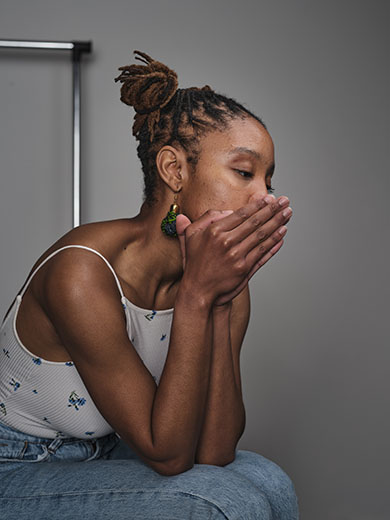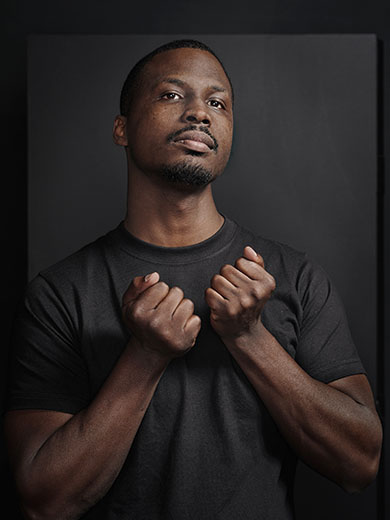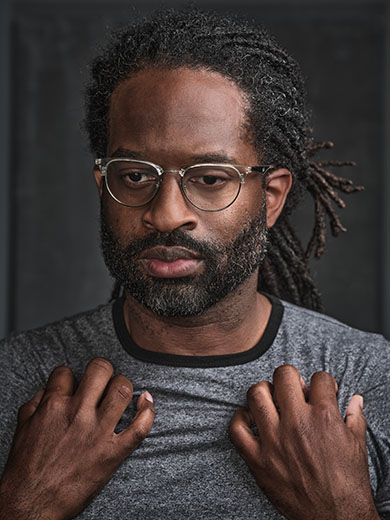All We Be: Collective Evocations
All Artists are at our best subversive selves when we are red with vulnerable rapture, ruddy with the mud of digging, and glazed in the musk of compulsion. This partly works in art and certainly lends itself to folly in real life because our minds are the eyes for the otherwise blindly driven. Since I started making artwork, I've wanted to be enraptured by such deep knowing and have found something in the politics of photographic poetry as a type of workshop for toiling through matters of portraiture, community, and the struggle for and over space, the rights, the sometimes-silent loneliness, and freedom in it all. These images are the expression of a space I am increasingly disallowing the frame to circumscribe and rigidly define. This project "All We Be" expresses the inevitable dynamism of Black experiences through a parallel critique of photographic portrait's failure to describe. Each image depicts nebulous gestural performances of collective memory. These catalytic images intend to transmit an understanding to some, to pull on the broadness and depth of our humanity through accessibility, perhaps, gained by the viewers' imagination and vulnerability should they choose share.
Expressed emotion can be more factual than written history, because feelings are real, and historiographies' products usually seem plausible but still more factually flexible than the saddest song's violet hue. To the artist, the truth is of no use, but the human spectrum of emotion is ever universally effective. After all, appeals are made to the most human parts of us. Expression is dangerous and more relevant than truth. The truth in "All We Be" is the form of transmission and not merely the hyper-realistic linework of what the photographic apparatus might use to communicate a description. The description is not clear, but dilemma's tension is always present, the dilemma that there are fair assumptions in the pictured form, but the performed language is not structurally clear.
These seeming portraits don't easily echo an established language. There is no key for gaining access. These are not bold didactic; they are poems written in jargon. Fact as evidenced in certain dominant languages, epistemologies, and philosophies can become echoes in photography. These are disruptive to the language that seems to disappear before its message. Visual language mostly makes statements, assertions, and expressions based on these widely established symbols. To speak another language in the domain of the dominant demands an adjustment of understanding and a shift in power, the way sometimes nebulous gestures in these images turn the proverbial table. There is a cadence when we find there is a different first language spoken in the room. This state of disequilibrium calls on imagination and willingness to determine the length of adjustment between communication modes. This process is at the heart of the work.
We are all part of various collective memories, and photography is a catalyst for that which has passed. Again, it is not a truthful illustration of what was, but it is an allusion to a faulty document. A photograph is more a written poem than it is a reasonably authoritative affidavit, and we know the faults of affidavits to be plentiful. Collective memories, however, value is in its cultural ability to strengthen bonds and remind us that we have always been spacious, and we have always been present—even in the past and futurity—enduring similar human struggles and speaking many first languages.

Anthony Francis is a photographic artist whose work considers the politics of portraiture. Communal gatherings have rendered the studio a place for shared yearning while critiquing the way his own intents fall short in the practice of a flawed apparatus. He holds degrees in English, an MA in Educational Administration, and an MFA from the Academy of Art University. He has exhibited nationally and abroad with shows including the McNay Museum and such talks and presentations at Black Portraitures in South Africa and Atlanta Contemporary for Descrit. His work has recently been acquired for the permanent collection of the McNay Art Museum, San Antonio.





